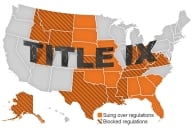You have /5 articles left.
Sign up for a free account or log in.
For the fastest growing student demographics, traditional face-to-face education often proves unrealistic.
Non-traditional students, who may have to juggle jobs and family responsibilities while also financing their schooling, frequently find it difficult to take a full-load of courses on a college campus. Instead, such students enroll part-time or sign up for fully online programs. Both options, practical as they may be, have far lower rates of student success, whether measured in terms of completion or leveraging their learning in some direct way, by obtaining a new job or a promotion.
Low-residency programs, however, offer an attractive middle-ground, combining the flexibility of online learning with aspects of the personal interaction found in a traditional campus classroom.
Unlike hybrid or blended learning, which is simply a variant on conventional instruction in which a course’s lecture component takes place online, low-residency programs break much more radically with the traditional model. In fact, blended and hybrid learning is by no means new, long having been used at business and law schools that employ the case method or in hands-on engineering programs.
For low-residency programs, face-to-face instruction generally takes place on weekends or for a week or two during the summer, with most of the instructional delivery and interaction taking place online. Such programs sometimes take advantage of off-campus extensions, where students can access support services and have the chance to interact with fellow classmates.
Surprisingly few non-profit universities have aggressively embraced the low-residency model. Those that have currently concentrate on MFA programs, usually in creative writing. In addition, a growing number of institutions offer low-residency programs at the executive level (the most common are Executive MBA programs), as well as hosting summer academies for executives. Still others offer specific summer programs for high schoolers.
But imagine if more students could benefit from the low-residency approach.
There is no reason why such programs shouldn’t be available to a far broader range of students, undergraduates as well as graduate students.
In fact, MOOCs have begun to experiment with such an approach. A HarvardX course developed by the Harvard Law School, CopyrightX, engages three kinds of approaches and communities:
- a residential course on Copyright Law, taught by Prof. William Fisher to approximately 100 Harvard Law School students;
- an online course divided into sections of 25 students, each section taught by a Harvard Teaching Fellow;
- a set of affiliated courses based in countries other than the United States, each taught by an expert in copyright law.
The latter group is a form of low-residency learning (as most of those groups gather in university settings) and it is intended to meet global students’ needs for interpersonal interaction, since most will not have the chance to experience the Harvard campus.
Such flexible programs might also be particularly appealing to transfer students and for those who are older than the 18-22 year olds who now comprise the bulk of undergraduates.
For students in their early or mid-twenties, low-residency programs might well prove superior to a fully online programs. Unlike distance education, such programs offer more structure, more opportunities to engage with faculty, and more chances to network with other students, as well as the prospect of developing a stronger identification with a particular university.
To be successful at the undergraduate level, low-residency programs are likely to benefit from several practices that have a proven record of success in online learning. These include a personal mentor, coach, tutor, or adviser, to regularly interact with the students and ensure that they remain on track. A competency-based curriculum combined with micro-credentials, such as badges or certificates or industry-based certifications that denote progress toward goal, can help sustain student motivation.
Models of low-residency education exist, as does a large potential market. Harvard University, in particular, has shown how successful short-term campus residencies can be in cultivating institutional loyalty. The question lingers: Is low-residency a model whose time has come?
Steven Mintz is the Executive Director of the University of Texas System’s Institute for Transformational Learning and a Professor of History at the University of Texas at Austin.







